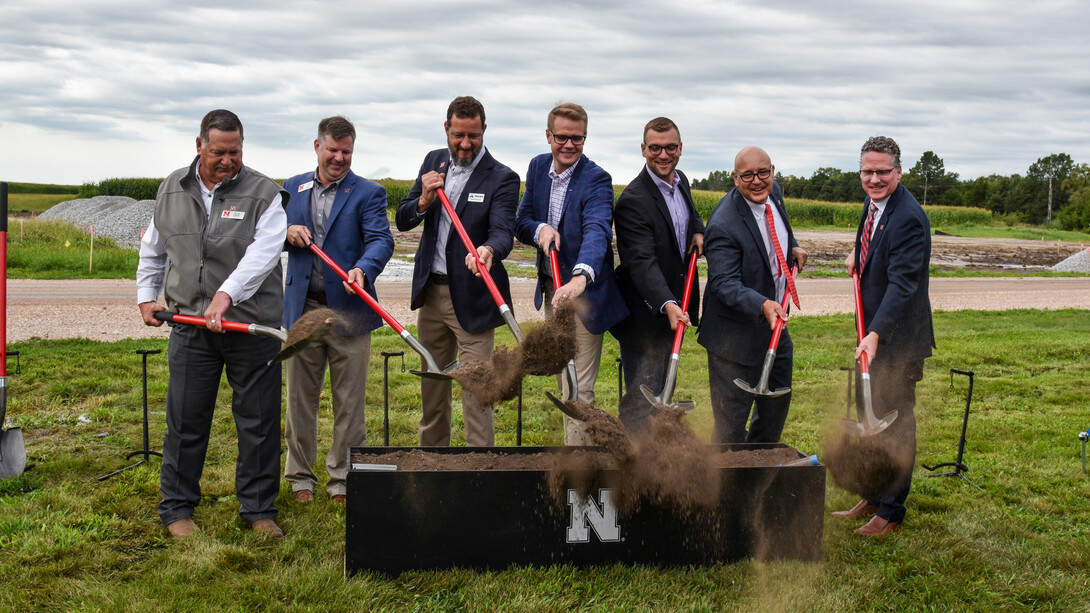
University and private-sector representatives pointed to major opportunities for ag tech innovation and collaboration in an Aug. 14 groundbreaking ceremony for NFarms, the University of Nebraska–Lincoln’s precision agriculture initiative.
“The research and learning that will come out of this facility will be invaluable to the industry, as well as to our growers,” said Kurtis Charling, vice president of agricultural technology for Lindsay Corporation.
NFarms (Nebraska Future Ag Research and Management Systems) formalizes the university’s existing research and outreach in precision agriculture into a strategic initiative. The multi-disciplinary work operates at commercial scale unique in university ag research on more than 3,000 acres of the university’s Eastern Nebraska Research, Extension and Education Center near Mead.
NFarms will offer particular value in facilitating public-private partnerships and ag-focused entrepreneurship, speakers said.
“We see enormous potential to leverage NFarms to test new ideas, products and concepts while getting expertise back from the great faculty and staff you have here,” Charling said.
The expansion of Lindsay’s ag tech research cooperation through NFarms will be extremely valuable to the company, he said.
Kent Kirchoff, vice president for sales and marketing with AKRS Equipment, noted his company’s focus on ag tech innovation and the benefits its partnerships with Husker faculty provide. Those collaborations boost producer efficiency by allowing innovative technology to be implemented on farms in Nebraska, he said.
“The research and innovation happening here can make it out to the commercialization stage that’s going to help producers,” said Joshua DeMers, program manager of The Combine, an Invest Nebraska initiative that partners with the university to support early-stage ag tech and food entrepreneurs.
Commercialized products and services stemming from NFarms research will provide Nebraska producers with “practical solutions, scalable and affordable,” DeMers said.
The groundbreaking event illustrated the university’s precision ag focus by having an NFarms drone take a core sample and share it just before a group of university and industry representatives put shovels to the ground. An ag robot pioneered by the Department of Biological Systems Engineering also provided a demonstration.

NFarms’s initial 5,000-square-foot building will house precise ag equipment with a long-term goal of creating a campus focusing on a range of projects, said Joe Luck, professor of biological systems engineering and associate director of ENREEC.
NFarms will address two key ag needs — data management for practical use, and efficient automation — by drawing on insights from fields including agronomy, plant pathology, computer science, engineering, statistics and software development, Luck said.
“It’s tough sometimes for companies to have access to all that expertise,” Luck said. NFarms will provide “a place where we can bring all that together and develop software tools or whatever is needed. We can embed that in our farm operation and test it.”
NFarms benefits not only from the 3,000 acres, but from ENREEC’s total 10,000 acres, including the Klosterman Feedlot Innovation Center.
“These are production-scale systems, meaning it’s near what our stakeholders have,” Luck said. “That gives us strong ability to create and test these tools,” boosting producer confidence in the technology’s reliability.
Another collaborative opportunity arises from the U.S. Department of Agriculture’s construction of its $160 million National Center for Resilient and Regenerative Precision Agriculture at Nebraska Innovation Campus. Digital agriculture will be one of the focuses at the USDA facility, opening possibilities for scientific collaboration with NFarms.
The university will look to a wide range of partnerships to develop innovative concepts to help Nebraska agriculture, said Mike Boehm, vice chancellor for the Institute of Agriculture and Natural Resources.
“We’re taking the best ideas from wherever they’re coming from and harnessing them to advance precision ag,” he said.
The resulting benefits for producers can include value-added products, increased operational productivity and greater profit opportunities.
Through such efforts, NFarms and the university overall will prove a “hot spot” in pioneering innovative ag technologies, said Derek McLean, dean of IANR’s Agricultural Research Division.
Public-private partnerships will be a central focus for NFarms, Luck said.
“We will be supporting an ecosystem for industry partners to come in and develop ties to our particular strengths — the production scale, the quality of the data, the execution,” he said. “That can be anywhere from supporting large companies to startup companies.”
As technology becomes an increasing part of modern agriculture, Charling said, “NFarms is going to play a vital role in shaping the future agronomist, engineer, farmer and cattle feeder. There’s no doubt in my mind that NFarms is going to give us a leg up in that area.”







